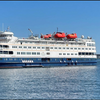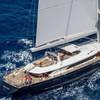Chicago Electric Fish Barrier Safety Analysed
The US Coast Guard apprises that a study by its Research and Development Center concluded that the current rules governing vessel traffic across Chicago’s electric fish dispersal barrier effectively address the risks posed by the barrier’s electrified waters.
The electric fish barrier system in the CSSC was built and is maintained by the U.S. Army Corps of Engineers to limit the spread of various aquatic invasive species, including Asian carp, between the Great Lakes and Mississippi River basins.
Coast Guard regulations prescribe operating rules and guidance for commercial and recreational mariners transiting the Chicago Sanitary and Ship Canal.
The study found that existing regulations substantially mitigate the risks associated with the barrier. While the total risk associated with the barrier was deemed relatively low, certain scenarios presented markedly higher risks. These higher risk scenarios involve a person falling into the water, either from a vessel or from the riverbank, and receiving an electric shock. The report makes recommendations that could further reduce these risks.
“Our primary mission is to safeguard people and vessels operating on the navigable waters of the United States,” said Cmdr. Scott Anderson, chief of inspections and investigations for the Coast Guard Ninth District. “Studies like these help confirm that existing regulations meet this goal and highlight areas where we can continue to improve public safety while facilitating marine commerce.”
The Great Lakes Restoration Initiative, in which the Coast Guard partners with 15 other agencies to rehabilitate the ecosystem's health and prevent the movement of aquatic invasive species into the Great Lakes, funded the study.
Details of the study are available at: http://www.dtic.mil/docs/citations/ADA594965















